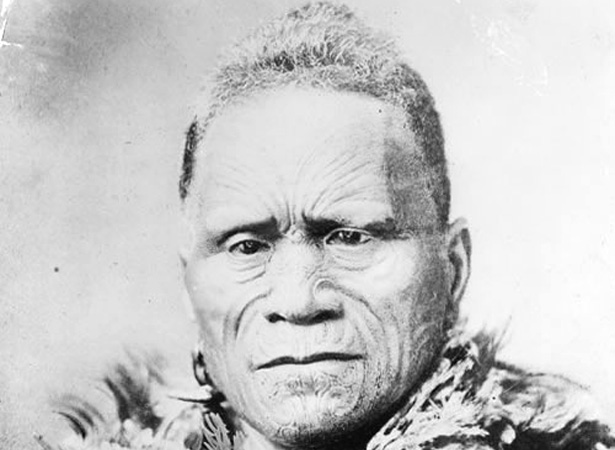King Tāwhiao, officially Tūkāroto Matutaera Pōtatau Te Wherowhero Tāwhiao, stands as a significant figure in Māori history. As the second Māori King, he was instrumental in guiding the Kīngitanga Movement through a period of profound challenge and change. His reign started in 1860, following in the footsteps of his father, Pōtatau Te Wherowhero, the first Māori King. Tāwhiao’s leadership spanned over three decades until 1894, during which he championed Māori autonomy and identity, particularly during the turbulent times of the New Zealand Wars.
Early Life and Ascension to Kingship
Born approximately in 1822 into the Ngāti Mahuta hapū of the Waikato iwi, Tāwhiao’s early years were shaped by the growing tensions between Māori and European settlers. Initially known as Matutaera, he later adopted the name Tāwhiao in 1864. His upbringing was immersed in the traditions and challenges of his people, preparing him to ascend to kingship in 1860 after his father’s death. This position came at a critical juncture, as Māori communities were rallying to protect their lands and sovereignty through the Kīngitanga Movement.
The Role of the Māori King Movement
The Māori King Movement, or Kīngitanga, emerged in the 1850s as a unifying initiative among various Māori iwi and hapū. It aimed to foster unity to resist land confiscations and the threat to Māori autonomy posed by increasing European settlement. The movement sought to establish a monarch who would act as a protector and symbol of Māori unity. King Tāwhiao’s role was crucial in solidifying the movement’s objectives, providing both spiritual and political leadership that resonated deeply with his people.
Tāwhiao’s Leadership During the New Zealand Wars
When the New Zealand Wars erupted in the 1860s, Tāwhiao found himself at the forefront of a significant struggle. These wars were primarily sparked by conflict over land ownership and sovereignty. As King, Tāwhiao became a beacon of resistance and leadership. His strategic insights and commitment to his people were crucial in sustaining morale and support throughout these challenging times. The conflict led to large-scale land confiscations, profoundly affecting the Waikato region and its communities.
Exile in the King Country: A Period of Resilience
Following the defeat in the Waikato War, Tāwhiao and his followers withdrew to an area known as the King Country, or Te Rohe Pōtae. This period of self-imposed exile lasted almost 20 years. During these years, Tāwhiao’s resilience shone brightly. He focused on community cohesion, strengthening the identity and culture of those in the King Country. His leadership during exile was marked by his ability to provide hope and a vision of eventual reconciliation and peace.
Return and Reconciliation with the Government
In 1881, King Tāwhiao and his followers made a brave move by returning from exile. This return was marked by a reconciliatory stance towards the government, seeking to repair relations and find peaceful solutions to ongoing disputes. Tāwhiao’s leadership during this time showcased his commitment to peace and was instrumental in shaping future negotiations. His approach underscored the importance of dialogue and diplomacy, even after years of conflict and estrangement.
Tāwhiao’s Visionary Leadership and Prophecies
Beyond his political accomplishments, Tāwhiao is remembered as a visionary leader. Many of his sayings are considered prophetic, reflecting deep spiritual insights and foresight. He envisioned a future in which his people would achieve economic self-sufficiency, and this vision influenced the development of strategies to enhance the prosperity of Tainui iwi. Tāwhiao’s prophetic voice continues to inspire, portraying a leader deeply connected to both his cultural roots and transformative goals.
The 1884 Delegation to England: Seeking Justice
In 1884, Tāwhiao embarked on a significant mission to England, seeking to address grievances related to the Treaty of Waitangi. He led a delegation with the hope of bringing Māori concerns directly to Queen Victoria. Although the delegation did not result in a personal audience with the queen, it underscored Tāwhiao’s dedication to achieving justice for his people on an international stage. This bold move highlighted the lengths he was willing to go to ensure that the voices of the Māori were heard and respected.
Establishing Kīngitanga Institutions
King Tāwhiao was instrumental in establishing key institutions that fortified the Kīngitanga Movement. These institutions aimed at maintaining the cultural, political, and social structures that underpin Māori identity. By doing so, Tāwhiao ensured that the movement remained resilient, evolving with time while staying rooted in its core values. His contributions laid a robust foundation for the movement to sustain its influence and relevance in New Zealand, echoing through the generations.
Conclusion: Tāwhiao’s Enduring Impact on Māori Identity
King Tāwhiao’s legacy is monumental, leaving an indelible impact on Māori identity and the wider New Zealand society. His leadership during tumultuous times, coupled with his visionary approach, solidified the foundation for contemporary Māori social and political frameworks. Tāwhiao’s efforts showed a path of resilience and cultural pride, emphasizing the enduring strength and adaptability of the Kīngitanga Movement. His story is a powerful reminder of the importance of unity and vision in the face of adversity, crafting a legacy that continues to shape narratives and identities to this day.
For more interesting articles, check out more in our website.
